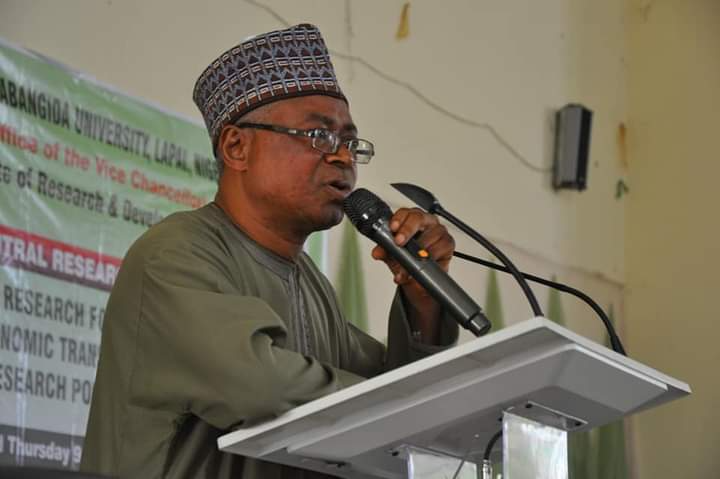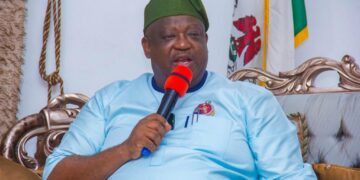NNPCL is set to commence drilling of oil wells in Nasarawa State. What do you expect from this exercise?
I expect success and commercial discovery in the first exploration well that will be drilled. At personal level, I and my team have been working in this area over many years. One of my research paper titled “micrinite maceral evidence of hydrocarbon generation in the Middle Benue Trough” published in the Journal of Mining and Geology in year 1999 was already a key statement on the prospects in the Middle Benue Trough. At the corporate level I have been funded by the NNPC Ltd to review the geology and stratigraphy of the Middle Benue Trough and together with some young NNPC Ltd geologists we traversed the Middle Benue Trough in year 2020 and more evidences were adduced.
NNPC Ltd through the FES has ran 2D and 3D seismic in the Middle Benue Trough not too long ago and prospects are easily readable on the seismic profiles. Other advanced technology methods have been deployed by the NNPC Ltd in the exploration of the Benue Trough such that the heavy risks usually associated with exploration activities have been hugely reduced. But we cannot say anything too confidently until the drilling is done. You can refer to me as a leading researcher on the Benue Trough but I would like us to recognize other high impact geoscientists who have contributed and still contributing enormously to petroleum exploration research of inland-frontier basins, namely, Prof Abubakar Sani Sambo who established the National Petroleum Research Centre, the first of its kind, which was hugely committed to inland basin research; Prof MB Abubakar, who was Director of the Centre (presently MD Galaxy Backbone), Prof CS Nwajide, Prof Emeka Ekweozor, Prof Sam Akande, Prof Sadiq Maigari (ATBU), Prof Ahmed Haruna (ATBU), Prof Alexander Lar (Uni-Jos), Prof Ibrahim Goni (Uni-Maid), Prof Faruq Zaki (UDUS), Dr SYD Babangida (BUK) and many others.
What is your take on the skepticisms from some quarters that the wells may turn out dry based on the age-long assumption that there is hardly crude deposits in the north?
Such skepticisms cannot stand again. The success and high volumes of oil and gas found in Kolmani River well in the Gongola Basin of the Upper Benue Trough should now translate to optimisms in all of Benue Trough exploration. Anambra Basin is a portion of the Lower Benue Trough and we have found oil there; Kolmani River is in the Upper Benue Trough and we have found oil there; so the middle of this trough cannot disappoint. People that have been saying that Nigeria cannot find oil in the Benue Trough or in basins in the North have never been to any of those basins neither have they taken any sample from this basin for analysis. It is just our usual sentiments.
Looking at the environmental challenges oil exploration threw up across the Niger Delta region in the past, what should we expect in terms of environmental impact assessment before full exploration commences?
Before you commence seismic acquisition and carry out drilling, you must have conducted an environmental impact assessment. This EIA had been conducted for the Middle Benue Trough long time ago. In all EIA studies, the environmental management plans including mitigation, remediation, compensation and monitoring plans would be stated and forwarded to Nigerian Upstream Petroleum Regulatory Commission (NUPRC) and the Federal Ministry of Environment; and the communities are fully aware and usually carried along. They will state their grievances and fears. You would give them the assurances to mitigate, remedy and compensate where such fears manifest in the course of exploration, drilling and production. And this must be done at regular intervals under the supervision of NUPRC and federal ministry of environment.
Going by your earlier analysis of the crude migration in the area, there are also prospects in Agwatashi in Obi local government area of the state and other communities. Do you foresee a possible relocation of the entire Keana town, Agwatashi and other settlements within the axis?
When we say Keana, definitely not directly in the town of Keana. A prospect or well is named after the nearest locality of settlement or any other objects. In many cases the prospect is way away from settlements but it can also be on people’s farmlands. And if the prospect falls unfortunately within a town or settlement, a cost-benefit analysis will be undertaken to decide whether to resettle the community. Whoever is searching for oil is also looking for money and profit. How big and commercially viable is the prospect that you want to resettle the community? And where it comes to that most communities are happy to be compensated and resettled, except some worries over ancestral items and objects.
Keana will be the first well to be drilled. It means that prospect is very visible and very viable to NNPC Ltd. That is just one prospect. If Keana brings good volume of oil/gas out, then investors’ confidence would have been boosted. NNPC Ltd or other investors will now have confidence to acquire acreages and begin further exploration activities around Keana or away from it. You know the search for oil and gas started in Nigeria around 1909, discontinued and resumed in 1937 by Shell D’Archy. All those years, no success. Then with luck and advanced technology at the time, Shell drilled in Oloibiri and that became the first well that struck oil in Nigeria in the Niger Delta. That was that; everybody started coming: Elf/Total, Chevron, ExxonMobil, Eni/Agip, Texaco, Indigenous, NNPC/NPDC, etc. Now Oloibiri is not more the hot spot. Obigbo, Buguma, Degema, Eleme, Kana, Gokana, Warri. Rivers, Delta, Bayelsa, Akwa Ibom, Edo States, they are now oil producing, not from Oloibiri but from new fields by the IOCs and Indigenous. So after Keana, exploration may move to Obi, Agwatashi, Adudu, Ribi, Awe, Doma and don’t forget Middle Benue, apart from Nasarawa, embraces Taraba, Plateau and Benue States. So exploration will expand into all these areas, depending on whether we have the desire to continue with oil as an economic commodity. But definitely Obi and Agwatashi areas also have good prospects.
What should the federal government do in order to avert the sort of challenges in the oil-rich Niger Delta?
The Niger Delta crises ensued because the people or let me say some people there believed Nigeria is surviving on their commodity and they were not getting enough in return, politically and economically, despite 13% derivation, NNDC, etc, including the large employment benefits. The assumption then was that oil is deposited only in the Niger Delta. Despite that, the Federal Government has already done a lot to assuage the situation through creation of Niger Delta Ministry, Amnesty Program and politically a Niger Deltan has ruled this country as President and Commander-in-Chief. What the Federal Government can do as we expand exploration and discoveries to other parts of Nigeria outside the Niger Delta is to ensure compliance to the Petroleum Industry Act which created a Host Community Fund. The communities are critical to success and deriving maximum economic benefits from oil exploration and production in Northern Nigeria, but also including Anambra Basin and Dahomey Basin.
Furthermore, the environmental management plans designed by the operators must be carefully and diligently enforced by the NUPRC and Federal Ministry of Environment. EIA reports contain issues on environmental management in cases of pollution and destruction to properties.
You are also working in Bida and Sokoto basins, what are your expectations from these areas?
What I have presented on the Benue Trough also apply to the Bida and Sokoto Basins. The Bida and Sokoto Basins are the western arm of the Central-Eastern Africa Cretaceous Rift Basins system, just like the Benue Trough is the eastern arm. Same tectonic processes produced them stretching to the Muglad Basin in Sudan, Doba, Doseo, Kanem, and Bongor in Chad Republic, the Agadez in Niger Republic, Anza in Kenya, etc. Through the initiation of IBB University, supported by the Niger State Government we have traversed the Bida and Sokoto Basins along with researchers from the Federal University of Technology Minna and the Usmanu Danfodio University Sokoto. We have done the geological propspectivity mapping, we have done geochemical studies. NNPC took over the exploration while allowing us to continue work in partnership. The Bida Basin covers Niger, Kwara and Kogi States and the FCT. Eighty percent of the surface area is in Niger State covering 11 Local Government Areas that include Bida at the centre, Edati (Enagi), Lapai, Agaie, Gbako, Mokwa, Mashegu, Katcha, Lavun (Kutigi), partly Wushishi and Kontagora. Sokoto Basin covers Sokoto, Kebbi and Zamfara States. Based on the studies we have done so far and based on data gathered by the NNPC Ltd, the prospects are there. NNPC will decide on the exact location to drill and thereafter, depending on the results and volumes of oil in the first well, other location will become blocks/acreages for acquisition by investors through the NUPRC. Everybody will benefit: employment, derivation, host community funds, increased businesses, CSR projects and Nigeria will book more reserves. All these analyses, however, should not deviate our attention from agriculture, solid mineral mining and entrepreneurship.











